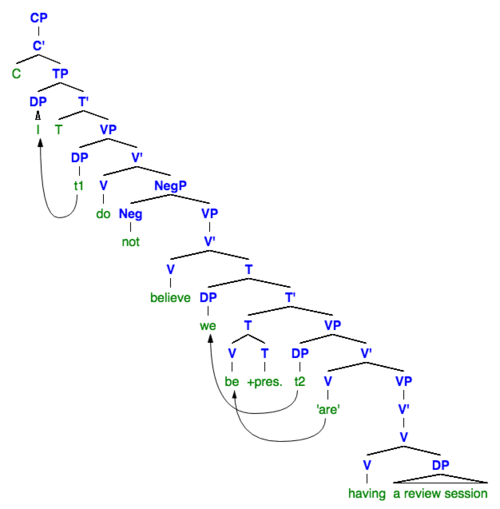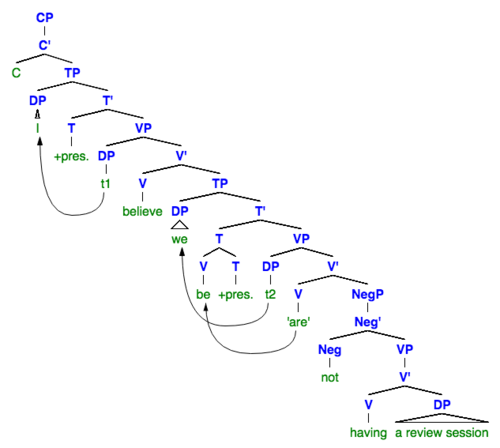NEG-raising in English
In the syntactic view of classical Neg-raising, a NEG raises from its origin, the place in which it originates underlyingly, to the host, the place in which sits in the surface representation. [1] In English, negative raising constructions utilize negation in the form of, "not," where it is then subject to clausal raising. [9]
Examples of English NEG-raising
In the phenomenon of negative raising, this negation cannot be raised freely with any given predicate.
Consider the following example proposed by Paul Crowley, in which the verb "say" attempts to display negative raising: [10]
- Mary didn't say it would snow
- Mary said it would not snow.
As seen in this example, "say" is not a predicate that can be used for Neg-raising, as the raising of the negation to the matrix clause creates the reading "Mary didn’t say it would snow," which holds a different meaning than "Mary said it would not snow," where the negation resides in the embedded clause. [10]
To account for this fact, Laurence Horn has identified 5 distinct classes to account for the general predicates involved negative raising, as seen below in English: [11]
| Class of predicate | Examples |
|---|---|
| Opinion | think, believe, suppose, imagine, expect, reckon, feel, guess |
| Perception | seem, appear, look like, sound like, feel like |
| Probability | be probable, be likely, figure to |
| Volition | want, intend, choose, plan |
| Judgement | be supposed to, ought, should, be desirable, advise, suggest |
Chris Collins and Paul Postal refer to these predicates as classical negative raising predicates (CNRPs). It is important to note that some CNRPs such as reckon and guess, exhibit more dialectal variation in their acceptability to speakers. They define what constitutes a CNRP as follows:
"If NEG raises from one clause B into the next clause above B, call it clause A, then the predicate of clause A is a CNRP." [1]
Consider the Perception predicate, "look like," in which we can posit the following readings:
- “It looks like [it will not rain today]”
- “It does not look like [it will rain today]”
In this regard, “It does not look like [it will rain today]” is seen as a paraphrase of “It looks like [it will not rain today]." This is because even with the raising of the negation to the matrix clause, both sentences convey the same meaning, thus the matrix clause negation is to be interpreted as if it were within the embedded clause. [11]
Analysis of English NEG-raising
In English, syntactically we can have negative phrase structures with the NEG in the matrix clause - the semantic interpretation of these phrases can be ambiguous; [12]
- The negation could apply to the verb in the matrix clause
- The negation could apply to the verb in the embedded clause
Phrase structure with ambiguous and unambiguous NEG interpretation
| Phrase structure with NEG in matrix clause | |
|---|---|
| Phrase | [DP I ] do not believe [TP we are having a review session] |
| Interpretation 1 | I don't believe that there's going to be a review session |
| Interpretation 2 | I believe that there is not going to be a review session |
Syntax Tree 1
| Phrase structure with NEG in embedded clause | |
|---|---|
| Phrase | [DP I ] believe [TP we are not having a review session] |
| Interpretation | I believe that there is not going to be a review session |
Syntax Tree 2
The English language has a rich inventory of operators; these operators (in this case NEG specifically), differ from each other in terms of their scope orders with respect to other operators (in this case Verb). When we look at negative raising - we are thus looking at the operator NEG, and its scope over the Verbs in a phrase. Sentence with negative raising are thus ambiguous in terms of NEG -
- In one reading NEG has scope over the matrix verb (Tree 1)
- in the other reading NEG has scope over the clausal verb (Tree 2)
Phrase structure showing NEG raising - from lower to upper position
This tree illustrates how NEG can be raised from the embedded clause to the Matrix clause; thus it can be pronounced in the higher position while retaining its scope from the lower position.
Horn clauses
Horn clauses, named after the linguist Laurence R. Horn, who discovered the constructions, are clauses which feature a that clause complement containing an extracted NPI, triggering negative inversion, and further undergoing subject-auxiliary inversion. [8] [13] Take, for example, the following clause where the NPI is highlighted:
I don't think that ever before have the media played such a major role in a kidnapping.
Chris Collins and Paul Postal define rules that Horn clauses must abide by a few rules: [8]
- They must be complements.
- They must be a complement of a CNRP as these manifest a strong reading for main clause negation
The following table shows examples of permitted Horn clauses: [8]
| Grammaticality | Sentence |
|---|---|
| Grammatical | I didn't expect that for any reason she would agree to that |
| Ungrammatical | *ever again would I agree to such a course of action |
The first sentence is grammatical as the Horn clause is a complement of a CNRP expect, and can therefore raise up to the main clause while still being interpretable in the embedded clause. The second sentence is viewed as impossible because the Horn clause is a main clause, and lacks an initial complementizer, such as that.
While the standard view of fronted NPIs is that they are indefinites or existentials, this raises an issue for the existence of Horn clauses, as negative Inversion is prevented. However, the nonstandard view of NPIs containing an instance of negation can explain how NEG is able to raise to the host. This is due to the conditions of the phrases that can be fronted in negative Inversion being met by the NEG as a part of the fronted NPI. Under the CNRP analysis of Horn clauses, the posited underlying structure does not yet have main clause negation or negative inversion.
The steps are detailed in the table below: [8] [13]
| Step | Sentence |
|---|---|
| Underlying representation | I do think that the media have [NEG1 ever before] played such a major role in a kidnapping. |
| Result of negative inversion | I do think that [NEG1 ever before] have the media <have> played such a major role in a kidnapping. |
| Result of NEG raising | I do [NEG1] think that [<NEG1> ever before] have the media <have> played such a major role in a kidnapping. |
| Resulting surface structure | I don't think that ever before have the media played such a major role in a kidnapping. |
Cloud of unknowing predicates
While Horn clauses are claimed to only be licensed by CNRPs, it is the case that other predicates which are non-CNRPs can also license them, such as know. Take, for example: [14]
I don't know that ever before have the media played such a major role in a kidnapping.
This is analyzed as having both an overt NEG in the main clause, which unlike the CNRP analysis, does not raise up from the embedded clause, and a NEG in the embedded clause. The NEG in the main clause accounts for the semantic negation of the main clause. The NEG in the embedded clause ensures that negative inversion can still occur by satisfying its requirements. Because the resulting negatives would not give a meaning similar to that of the above sentence, an additional covert NEG is added to the complement clause. Both occurrences of NEG in the complement clause would then undergo deletion. [14]
| Step | Sentence |
|---|---|
| Underlying representation | I [NEG1 know] that the media have [[[<NEG2 SOME ever] before] played such a major role in a kidnapping]. |
| Result of negative inversion | I [NEG1 know] that [[[<NEG2> SOME ever] before] have the media played such a major role in a kidnapping]. |
| Result of additional NEG | I [NEG1 know] that [<NEG3>[[[<NEG2> SOME ever] before] have the media played such a major role in a kidnapping]. |
| Resulting surface structure | I don't know that ever before have the media played such a major role in a kidnapping. |
Strict negative polarity items (NPIs)
Strict NPIs, like breathe a word, require a clause internal licenser as they are subject to syntactic locality constraints. However, negative raising is known to license strict NPIs, as seen in the following example, where the negation is in the main clause rather than the embedded clause: [13]
Stanley doesn't believe that Carolyn will breathe a word about it [13]
Phrase structure showing NEG- raising licensing a strict NPI
This suggests that the negation originates in the embedded clause, as sister to the VP breathe a word, thus satisfying the locality of selection, being in the embedded clause before participating in raising, moving first to spec CP, and then to its host in the main clause. The analysis proposed by Chris Collins and Paul Postal draws on minimalist syntax, where the negation moves up to the specifier position of the functional projection, Negative Merge Phrase (NMP). Though the phrase is covert, the spec NM position acts as the host to the raised negation. [1]
Island constraints
Movement of negation from the embedded clause to the main clause is blocked in a variety of cases where a syntactic island is formed, as exemplified by The Island Sensitivity of NEG Raising Condition: [1]
"If K is a clause and an island, then NEG cannot extract from K."
Wh- islands
Neg-raising is not permitted in wh- islands. Consider the following examples, where negation is only permitted in the embedded clause and not the main clause, despite the ability of negation in the main clause to license strict NPIs: [1]
| Grammaticality | Sentence |
|---|---|
| Grammatical | I planned how not to tell a living soul about the money. |
| Ungrammatical | I did not plan how to tell a living soul about the money. |
This can be explained by the wh- word how undergoing movement first, filling the space in spec CP. Once this happens, negation can no longer participate in cyclic movement by stopping in spec CP before moving to the host NM in the main clause. The resulting violation of cyclic movement gives us the ungrammatical sentence. [1]



